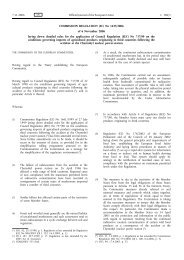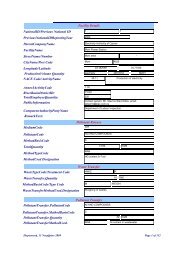Non binding guide to good practice for implementing Directive
Non binding guide to good practice for implementing Directive
Non binding guide to good practice for implementing Directive
- No tags were found...
Create successful ePaper yourself
Turn your PDF publications into a flip-book with our unique Google optimized e-Paper software.
<strong>Non</strong> <strong>binding</strong> <strong>guide</strong> <strong>to</strong> <strong>good</strong> <strong>practice</strong> <strong>for</strong> <strong>implementing</strong> <strong>Directive</strong> 2002/44/EC (Vibrations at Work)A starting point in your risk assessment is <strong>to</strong> consider thework being carried out, the processes involved and themachinery and equipment used. Some questions <strong>to</strong> helpyou decide whether further action is required are shownin Table 1.All types of vehicle, when in motion, are likely <strong>to</strong>cause the driver <strong>to</strong> experience whole-body vibration.Further reading:Manual Handling <strong>Directive</strong>:The risks <strong>to</strong> health increase where people areregularly exposed <strong>to</strong> high levels of whole-bodyvibration over a long period. Some vehicles thathave been associated with whole-body vibration andergonomic risks are shown in Figure 2. Remember thatwhole-body vibration exposure may also arise fromnon-driving activities, e.g. where workers stand onvibrating plat<strong>for</strong>ms.Council <strong>Directive</strong> 90/269/EEC of 29 May 1990 on the minimum health and safety requirements <strong>for</strong> the manualhandling of loads where there is a risk particularly of back injury <strong>to</strong> workers (fourth individual <strong>Directive</strong> within themeaning of Article 16(1) of <strong>Directive</strong> 89/391/EEC)TABLE 1 QUESTIONS TO HELP DECIDE WHETHER FURTHER ACTION MAY BE NEEDEDDo you drive off-road?High levels of whole-body vibration are most likely <strong>for</strong> people who drive vehicles over rough surfaces as par<strong>to</strong>f their job, <strong>for</strong> example off-road vehicles such as trac<strong>to</strong>rs, quad bikes, and dumper trucks.Do you drive or operate vibrating machinery <strong>for</strong> a long time every day?The fac<strong>to</strong>rs that govern a person’s daily vibration exposure are the magnitude (level) of vibration and the lengthof time the person is exposed <strong>to</strong> it. The longer the duration of exposure, the greater will be the risk from vibrationexposure.Do you drive vehicles that are not designed <strong>for</strong> the roadway conditions?Some industrial vehicles, such as <strong>for</strong>klift trucks, do not have wheel suspension and are fi tted with solid tyres, <strong>to</strong>provide them with the necessary stability <strong>to</strong> work safely. Provided they are driven on smooth surfaces wholebodyvibration levels should not be high. However, if they are driven on unsuitable surfaces (e.g. a <strong>for</strong>k-lifttruck designed <strong>for</strong> warehouse use being operated in a external loading yard), they can generate high levelsof whole-body vibration.Do you drive over poorly maintained road surfaces?Most road vehicles will generate fairly low levels of whole-body vibration provided the road surface is wellmaintained. Cars, vans and modern designs of suspended-cab lorries are generally unlikely <strong>to</strong> present arisk from whole-body vibration when used on well-maintained roads. However, vehicles with less effectivesuspension such as rigid body lorries may cause high levels of whole-body vibration, particularly when they aredriven over poor surfaces, or when they are unladen.66


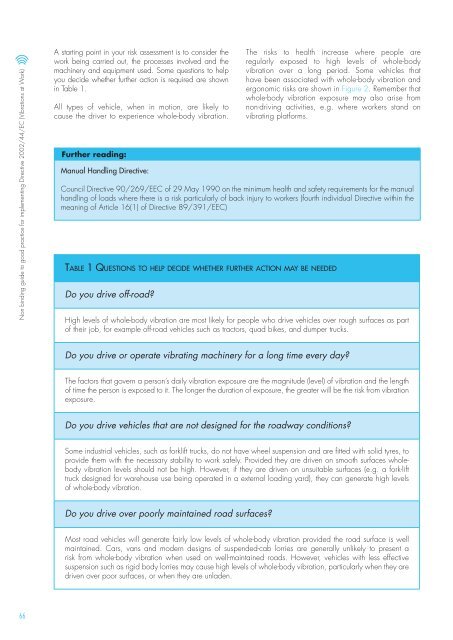




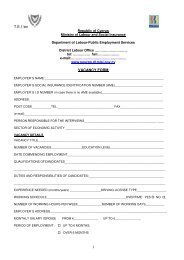

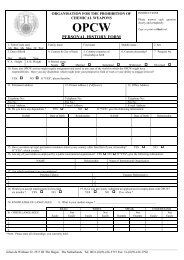
![Hadjimichael[1].pdf](https://img.yumpu.com/33937965/1/190x135/hadjimichael1pdf.jpg?quality=85)

